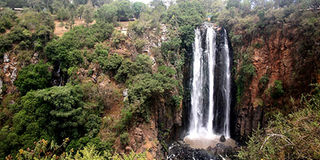The wonders of Nyahururu

The Thompson Falls. Photo | John Fox
What you need to know:
- Thompson’s Falls, its lodge, nature trails and a hippo sanctuary are some of the pleasant surprises in Kenya’s highest town
We had taken some visitors to the Nairobi National Park. We were high up on the edge of the forest at Impala Point and scanning the plains with binoculars — and I was showing off.
“See over to the left, at 10 o’clock, there are zebras moving along the track; in the trees at 2 o’clock there is a small herd of buffalos near the trees on the horizon — and right down below us there are some Thomson’s gazelles ...”
“So who was Thomson?” one of the visitors asked.
“He was a young Scotsman, and one of the early European explorers of East Africa. There’s also a waterfall named after him. There was a town, too, but it’s now called Nyahururu.”
And that was the trigger. On Easter Monday we took off for a drive to Nyahururu and the Thomson’s Falls.
We followed the familiar, and very busy, high road to Naivasha; turned off to the garrison town of Gilgil; got confused there because there are no signposts, and then headed straight north, through the farming town of Ol Kalou, and on to Nyahururu.
It is quite a scenic road, following the humped lines of the Aberdares to the east. It is 185 kilometres from Nairobi; so a drive of between two and a half or three hours — depending on the traffic or your temperament.
In the bustling, un-signposted town of Nyahururu, we stopped to ask a mzee the way to the Thomson’s Falls Lodge. He told us, and he also asked where we were from.
“Are you from London?”
“No, not for many years — we are from Nairobi.”
“Oh, good — and how is Kibaki doing?”
We were not sure how to respond to that. But, after something like “Fine, fine, we think,” we moved on.
The Lodge was a nice surprise. It is one of those old settler hotels, like the Blue Posts at Thika or the various colonial clubs in towns such as Kisumu, Kitale or Eldoret.
When we over-nighted at the Lodge some 15 years ago on our way to Samburu, it was rather run-down. But there have been some extensions and renovations, without losing the original character of the place.
The dining room is made welcoming with red plaid cloths favoured by the Maasai; the bar is small and cosy; the bedrooms still have their fireplaces to keep you warm (Nyahururu, at nearly 8,000 feet, is the highest town in Kenya); the public toilets are tiled, fitted with soap dispensers and blow hand-driers – and are the cleanest we have seen in any similar up-country hotel.
We had lunch (a very good lunch, at a reasonable price, from a wide-ranging menu) in the garden, at one of the round rustic tables, with round wooden benches, and under round safari-style parasols.
There it was obvious that this is very much a family-friendly place. There were lots of families there, with the parents enjoying their drinks and their chats, as the children romped on the swings and the slide.
There were a few tourists, too. Because, down at the bottom of the garden is the main attraction — the Thomson’s Falls, on the Ewaso Narok River and dropping 243 feet.
There are other things to do within the neighbourhood. A nature trail starts at the base of the falls and leads through the gorge. Among the trees there are colobus monkeys, baboons, other smaller animals — and so many colourful birds. Nearby, there is a hippo sanctuary.
And Nyahururu is within striking distance of the Aberdare National Park, the Ol Pejeta Conservancy with its chimpanzees, and the Solio Ranch with its many rhinos.
I wonder what Joseph Thomson would make of this place that carries his name? It was very wild and dangerous, he claims, when he was in these parts in 1883.
His mission was, as he tells us in his book, Through Masai Land, “to find out whether a useful direct route for European travellers exists through the Masai country from any one of the East African ports to the Victoria Nyanza.”
He describes it as “one of the most difficult undertakings” that meant facing “a tribe whose very name carried fear into the hearts of all who knew it”.
He would have to admit, I think, that these days there is perhaps more danger in driving the roads along the Rift Valley than there was in those days walking along sandy tracks through the bush.
But I’m sure he would enjoy the comforts of the lodge and appreciate the peaceful scene of the garden that leads down to his Falls.
John Fox is Managing Director of iDC




